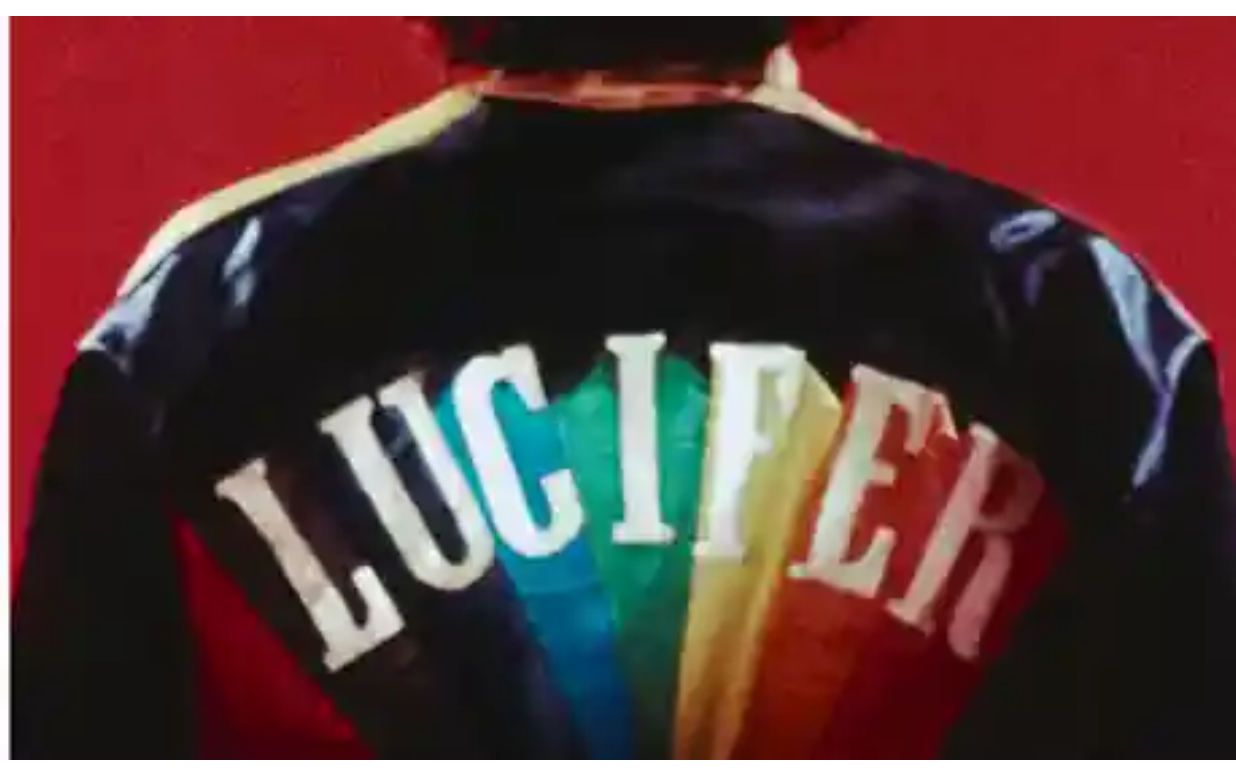
Kenneth Anger, Lucifer Rising 1966-1981
Kenneth Anger, Lucifer Rising 1966-1981 Text © Paul Drummond 2021
Kenneth Anger’s film Lucifer Rising has gone through many incarnations, from the incomplete 1967 original to a remake that took from 1970-1981 to fully realise – not to forget four attempted soundtracks – 1967: Bobby Beausoleil, 1969: Mick Jagger, 1972-3: Jimmy Page and the final Beausoleil version 1979-1980.
Confused? I was.
The theme of Lucifer, the light bearer, first manifested in Anger’s work when he was only 17 years old, when he portrayed “The Dreamer”, with his 1947 film Fireworks. As Anger noted in the 1966 Magical Lantern Cycle Spring Equinox programme, “a dissatisfied dreamer awakes, goes out into the night seeking ‘a light’ and is drawn through the needle’s eye. A dream of a dream, he returns to bed less empty than before.” The dreamer conjurors a group of sailors by striking matches, they beat him senseless as a youthful rite of passage – all directed with a heavy sadomasochistic overtone. Lacking any special effects, he hand-painted a flash of light representing Lucifer directly onto the film negative.
Following initiation into Aleister Crowley’s Ordo Templi Orientis, Lucifer Rising was intended as a celluloid homage to the order’s foundation on ancient Semitic, Babylonian and Egyptian deities. Inspired by Crowley’s poem Hymn to Lucifer, Anger’s project originated in San Francisco in 1966. His Lucifer wasn’t tainted by the Western-Christian devil, that confusion originates with a mistranslation (circa 1611) for the King James Bible. Anger’s Lucifer was the Greek ‘bringer of light’, Lucifer is also the Roman name for the planet Venus in its early morning aspect. Lucifer was the Promethean fallen angel who delivers divine knowledge to humankind.
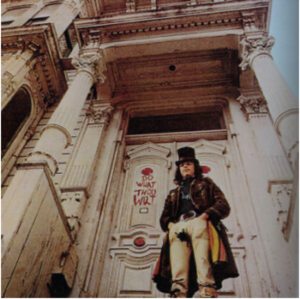
According to Bill Landis’ 1995 Unauthorized Biography, the original Lucifer was Godot, the infant son (he died aged three) of ]Laurel Canyon ‘freak scene’ instigators Vito & Szou Paulekas. Supposedly during 1966 any young man who lodged with Anger was labelled Lucifer ….In mid 1966 Anger moved from his North Beach apartment above The Movie, an art house cinema at 1032 1/2 Kearny, where he had screened Scorpio Rising in 1964, to the far more salubrious Westerfeld House on Alamo Square. The 28-room mansion was built by a German-born bakery & confectioner William Westerfeld in 1889. In 1928 it was acquired by Russians, who transformed the ground-floor ballroom into The Dark Eyes nightclub. The building was nick named the “Russian Embassy”, causing much confusion that it actual was the Embassy….
In 1965 it was acquired by future Rolling Stone magazine co-founder Charles Fracchia who rented it out. 10 years later in 1975 , his Straight Arrow Press published, an official English language edition in of Anger’s 1959 Hollywood Babylon. Click here: The story of Kenneth Anger’s Hollywood Babylon
In mid 1966 Kenneth Anger took over most of the ground floor of the building, that was until Bobby Beausoleil moved into the ballroom which also became his rehearsal space. Anger’s rooms were situated at the back, his bedroom painted purple with a black ceiling and mirror ball strung in the centre.
Bobby Beausoleil was then a 19-year-old wannabe musician from Santa Barbara. As he “went with the wind” and drifted down the coast, he’d joined Arthur Lee and The Grass Roots in L.A just as the evolved into the seminal psychedelic band Love. But sadly, he didn’t stay and continued to San Francisco where, inspired Sun Ra’s Arkestra, he formed The Orkustra. They performance can be found mainly on the bottom line of posters, supporting the likes of Janis Joplin during her Big Brother days.
How & when Anger and Beausoleil’s paths first crossed is impossible to determine since they’ve both heavily invested in their own self mythologies. While Beausoleil has suggested it, they could have met whilst at an orgy in a church, or playing at the Brave New World (an after-hours L.A gay club in 1965).
On January 14, 1967 Anger and Beausoleil attended the Human Be-In in Golden Gate Park which featured all the usual suspects from the counter culture movement, including Ginsberg & Leary. The only female contributor on stage was Lenore Kandel who read from her notorious The Love Book. Although Kandel was a known ‘Beat’ (she featured as Romana Swartz in Jack Kerouac’ Big Sur) she was more infamous for her own work – The Love Book. Published in 1966, the 4-page pamphlet contained a 4-part poem “To Fuck with Love.” Although copies were ceased from the Psychedelic Shop & City Lights as obscene literature and she was convicted by a jury for obscenity, Lenore won the appeal in what became a notorious trial in itself. Click Here : The Love Book by Lenore Kendal : 1966 1st Edition/ Printing (banned book)
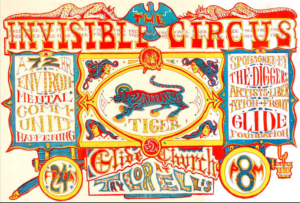
While one source claims that Anger cast Beausoleil as Lucifer at The Invisible Circus (a legendary three-day Diggers’ event, beginning 24th February 1967). While they clearly already knew each other previously, the Invisible Circus event was an important coming together of people involved in Lucifer Rising Mark 1. The event, staged at Glide Church, was supposed to ‘a happening’, the embodiment of the Digger’s Liberation Front. Anger attended as representative of the Kinsley Foundation (who’d funded Anger’s trip to Crowley’s Abbey of Thelema in 1955). Poets Richard Brautigan and Lenore Kandel both appeared alongside various bands including one of Beausoleil’s final performances with the Orkustra. Whether the event actually lasted three days isn’t documented, but distraught church officials ejected everyone for performing live sex acts….
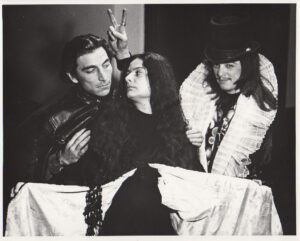

The exact arrangement between Anger and Beausoleil isn’t exactly clear…. anyone staying at the mansion was immediately dubbed the new Lucifer. As Landis points out in his 1995 biography – the palatial Westerfeld mansion was a step up from the squalid hippie crash pads off Haight street – with the added advantage of plenty of rehearsal space in the ballroom. Soon after his arrival Beausoleil formed The Magick house of Oz (Anger advised against ‘OZ’ because of Frank Baum’s OZ books) to record a compose music for the film. The idea being that Beausoleil represented youth (Anger was 39 -Beausoleil 19) and the coming of the new age of Aquarius. The role of ‘the angel of disobedience’ appealed to Bobby’s theatrical, narcissistic peacock -dandy persona.
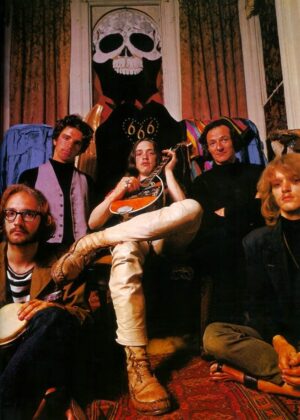
The top floor of the mansion was occupied by another film-maker Richard Patton, who assisted as a camera operator. Madeline Uribe, who occupied the basement, helped with art/costume department. With most of his cast and crew under one roof, Anger’s Lucifer project was becoming a reality.
Beausoleil was eager to make a start the project and continually pestered Anger – who got angry. Conceiving a project was one thing but funding it was another. Filming began in Anger usual fragmentary style, which confused and upset Bobby. The footage of The Magick Powerhouse of OZ with Kandel and Fritsch descending the staircase (used for the ending of the eventual Invocation of the My Demon Brother*) much as anything to appease Beausoleil. Other snippets filmed at Westerfeld, such as Beausoleil smoking a skull pipe and passing it to Kandel and Fritsch, were shot reportage style- Anger spotting something and grabbing his camera to capture an otherwise fleeting moment. How much of Lucifer Rising Mark 1 was ever shot is mystery that has never been resolved, with conflicting stories of kidnapped stolen footage…. However, on 21st September 1967 what could be described as Lucifer Rising “the stage-show” was performed at the Straight Theatre on Haight St.
Click Link for Horizon Art’s Periodical : Featuring Don Snyder’s Beausoleil photos : Horizon periodical 1968 “The Hippies’ Article : 1 Don Synder’s Bobby Beausoleil photo, Leary, Psychedelic Art, Morning Star commune
Again Beausoleil & Anger telling conflicting stories – was it a Powerhouse of OZ gig, as Beausoleil recalls with Anger only being three days prior – or Anger, the Magus, conjuring the New Aquarian Age at the Autumn Equinox. While Beausoleil, in Landis’s biography, claims Anger performance was ‘a disaster’, he took acid and when the prepared specially tape broke, the band had to come to his rescue while he flailed around on stage waving various hastily found props- completely out of his mind. Anger’s version as told to the Berkley Barb’ at the time was that 4 rolls of film, each containing 400ft of the original Lucifer Rising master print were locked in a trunk back stage, after they had been screened that evening, along with tapes for the soundtrack, props, banners and lights. What exactly was shown that evening as an early cut or work-in-progress remains a mystery. Accounts that state nothing was filmed beyond the few shots in the ballroom and staircase of at Westerfeld House are supported by the fact that the only photographs that have surfaced are of exactly the same scenes.
The poster for the event by Randy Salas must have had direction from Anger, since it’s inspired by the Ankh-ef-en-Khonsu stele in the Egyptian museum (inventory # 666) that instigated Aleister Crowley to scribe the Book of The Law in 1904 (published in 1909). 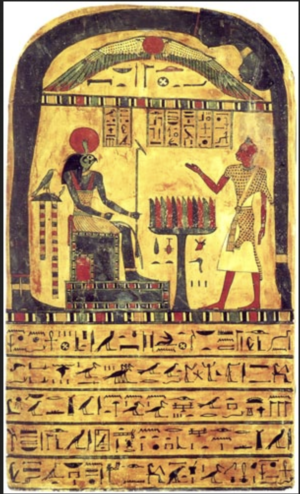
Reg Williams, who ran the Straight Theater, recalls (http://www.thestraight.com/wall.html), “Beausoleil had been portraying Lucifer in Kennth Anger’s work in progress “Lucifer Rising” which was projected as part of the “show”. Kenneth returned to the theater office the next day and accused us of stealing the now-missing film. We said that we had not and as I rose to show him the way out, he accused me of towering over him and threatening him. We cleansed ourselves of the situation by performing a ceremony at the public trash basket to rid ourselves of two bad elements on Haight Street and flet we were protected from both situations at once. Kenneth soon decided that Bobby had the missing film.”
The surviving footage of the evening, shot film masker and light show artist Ben Van Meter, (used later in Invocation of the My Demon Brother) is nothing short of startling. The recreated scene, shot in Robert Fraser’s London basement, is no comparison to the highly animated (and sped up) footage of Anger whirling around the stage, conjuring deities from a magic circle.
Recently fans have edited the 24 mins+ of music recorded at the event (now regarded as Lucifer Rising soundtrack #1) with the Lucifer Rising Mark 1 footage- used in Invocation of the My Demon Brother (see end of blog for link) to great effect.
Note : the sound recording recording of the Magic Powerhouse of OZ performing the soundtrack music dates from an earlier rehearsal in August at the Straight Theatre – not the event.
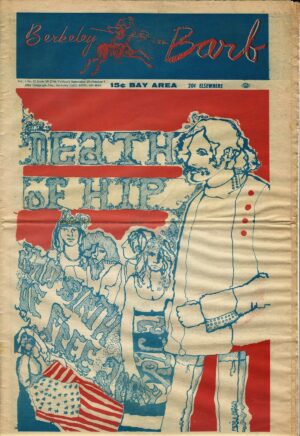
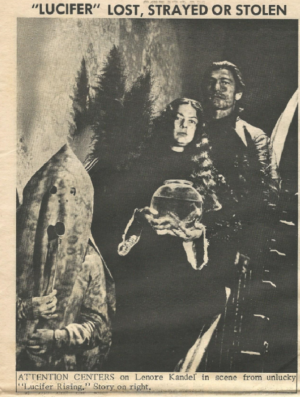
Exactly what followed is sketchy. Accounts have been revised as old grievances were resolved. …Anger in the Berkely Barb’ article from October 1967 claimed the theft was an inside job, one of a spate of thefts from the theater and he even offered a reward. In Beausoleil’s account he returned to Westerfeld, to find it locked and he peered through the windows and saw all his possessions in the ballroom covered in white sheets, including the battery from his car which was placed on an altar. He broke in, reconnected the battery and split….Beausoleil was reported to the authorities for the break in at Westerfeld (and draft dodging) and later accused of stealing the Lucifer footage by Anger.
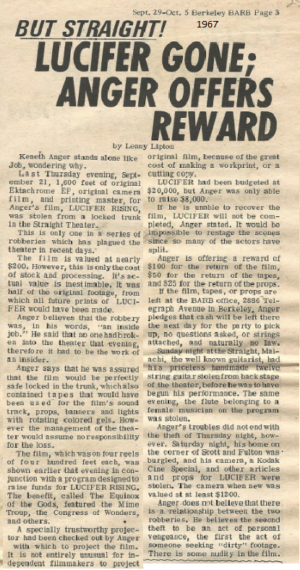
In October Anger participated at the levitate the Pentagon happening. While one account has him standing with the Diggers, brandishing his now infamous Lucifer chest tattoo and yelling ““Out! Demons Out!”, in another he claims to have worn a conservative suit and distributed 93 (Thelema #) talismans in men’s rooms, then left, not wanting trouble since he had a ticket for the opera.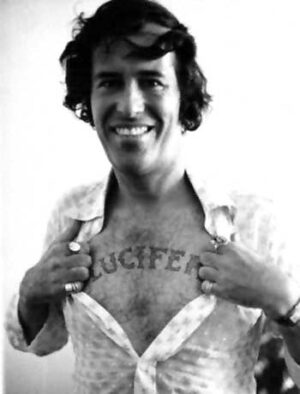
There was a previous disagreement over $700 that was invested in marijuana, instead of instruments. As Anger later commented in Magier des Untergrundfilms, shot during the making of Lucifer Rising II, “the angel of light turned out to be a devil in disguise.” Worse still, his Lucifer was now involved with the devil incarnate – Charles Manson. For all the mystique surrounding Manson, he was nothing more than a celebrity hustler who resorted to supplying drugs to ingratiate himself. A failure, he bitterly retaliated with a psychotic extortion racket that resulted in multiple murders.
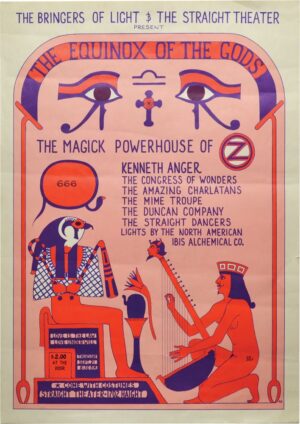
Supposedly, when Beausoleil’s vehicle broke down in the desert, he was seduced into Manson’s “family” of dumpster harpies. In one account, the allegedlystolen Lucifer Rising footage was “held ransom” at Manson’s lair, The Spahn Movie Ranch, a derelict film location in the desert. Anger was briefly hospitalised for exhaustion and while still furious, but not wanting to battle the devil, Anger quit the US for Britain. Whether Anger flew into one of his rages and split in a tantrum it proved a wise decision, since thing in California got increasingly dark for Beausoleil who was jailed for involvement, the Manson’s instigated, murder of Gary Hinman in July 1969. An ‘Angery‘ hex?
Prior to leaving, Anger declared his own death (as a film maker) with a full page “in Memoriam” (as Crowley had done previously) in the Village Voice (26th October 1967).
…The only ephemeral evidence would seem to be a poster dated 1967, designed by Rick Griffin. He lifted an 1870 engraving by Gustave Dore of Lucifer rising to heaven from an illustrated edition of Milton’s 17th C.E. epic poem Paradise Lost. In 2013, I showed a copy to Anger and dared to inquire- he was professionally dismissive: “just an early version“. However, according to Beausoleil, in Landis’ biography, the poster was printed prior to filming as a promotional tool to raise funds…. It was printed Bonaparte who produced merchandising posters for psychedelic venues such as Avalon Ballroom and sold via the headshop network.
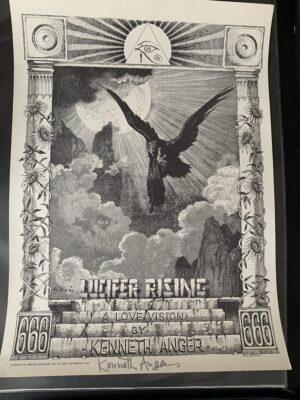

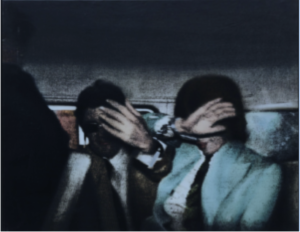
During a tour of North Africa, Europe and Britain in the early 1950s, Anger met Robert Fraser in London. Despite his privileged Etonian schooling, Fraser was every bit as maverick as Anger. Not only could he pass himself off at high society functions but – also gay –he could penetrate the criminal -gay- underworld of the Krays. He even claimed to have slept with the future Ugandan dictator Idi Amin! Since opening the Robert Fraser Gallery in the early sixties, he was internationally renowned as one of the most influential pop-art dealers. As a fixture of Swinging London, the pop elite flocked to him… Not only did he commission two of his artists, Peter Blake and Jann Haworth, to design The Beatles’ Sgt Pepper’s LP cover but another of his artists, Richard Hamilton, designed the conceptual “White Album” package (the polar opposite of Pepper). If that wasn’t enough, when he sold McCartney a Rene Magritte painting of an apple, he planted the seed for the name of The Beatles’ new business venture. In terms of pop-culture, no one was more influential than Fraser. Anger’s lavish programme for his 1966 Spring Equinox- Magical Lantern Cycle screening at the Film Maker’s Co-operative (his distributors) in New York, notes that,”prints for private collectors are available from the Robert Fraser Gallery”. Fraser was well known in London’s hip circles for his screenings of otherwise unavailable underground films -such as Warhol’s Chelsea Girls was first screened at his Mount Street apartment.
By 1968 the dream of Swinging London was in decline and so was Fraser. He was the only person involved with the infamous 1967 Rolling Stones drug bust to be jailed (for heroin possession). Hamilton immortalised the press coverage with his Swingeing (sic) London series of artworks.
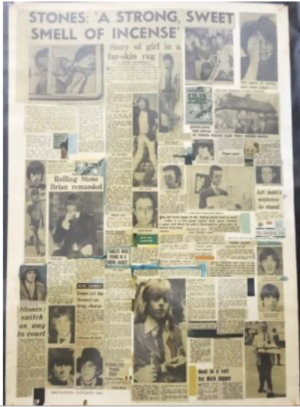
However, Fraser’s attitude to heroin was clear: the only problem was not being able to afford a good, clean supply. As the psychedelic haze of the summer-of-love evaporated, he introduced his pop-star elite to opiates, the new drug-du -jour.
In a BBC documentary Anita Pallenberg freely admitted, “Robert turned me on to heroin“. He was probably (if not -almost certainly) the source too for her boyfriend Keith Richards, also Marianne Faithfull and John Lennon (errand boys were often sent from Apple HQ on Saville Row to collect ‘packages’ from the Gallery around the corner on Davies Street). In Miles’ biography of him, McCartney confesses that he tried heroin once- at Fraser’s instigation.
In 1967 Ajit Moorkerjee published an influential book, Tantra Art. For the recently enlightened it was a revelation. The Beatles were all sent copies by Miles from the Indica Bookshop. Meanwhile in Texas, Tommy Hall of the 13th Floor Elevators, selected the same two images as the front and back covers of the band’s seminal Easter Everywhere LP, that Harrison had painted on the roof and bonnet of his psychedelic mini (as seen in Magical Mystery Tour). While Easter Everywhere remains THE psychedelic LP of 1967, it went ignored by the wider record buying public, who instead, opted for Sgt Pepper. Allegedly Mookerjee, unhappy with Harrison’s plagiarism, tried to sue until it was established that repainting ancient artworks didn’t constitute copyright violation.
Upon his release from prison Fraser switched from dealing in superficial pop-art to eastern religious artefacts- particularly Tibetan prayer scrolls. Eventually, he quit the UK to study Sufi trance dance in India. Nik Douglas, (ex-pirate radio Caroline) was one of the ‘regulars‘ at Fraser’s flat on 23 Mount Street and knew Mookerjee via his travels collecting artwork in India and Tibet. Fraser proposed to reopen the gallery (which had remained closed while he was in prison) with an exhibition of Douglas’ inventory. Douglas recalls (in Harriet Vyner’s excellent biography of Fraser, Groovy Bob) the gallery being in “disarray” and instead Fraser sold much of Douglas’ collection privately – a lot to John Lennon.
Douglas also proposed filming the Kumbh Mela Festival, (held every 12 years) in Rishikesh, India. Fraser loved the idea and formed a production company. “The Stones” agreed to fund the venture – how could they refuse after the bust? Kenneth Anger was invited to tag along, in what became an unscripted, Magical Mystery Tour style film project. While this might have been the post-prison “sojourn” Fraser needed, it left Douglas burdened with the responsibility of directing while producing –in India, which is always chaotic. ‘The plan’ was to join the Beatles in Rishikesh where they’d be studying transcendental meditation with the Maharishi Yogi (February-April 1968). With everyone either high, arguing, or both, Anger dubbed the project Tantrum not Tantra. When he was asked to step in and salvage the project, he split to Egypt taking camera and film stock.
(The Tantra film, was available to view in Vimeo but has been deleted, the Amazon DVD link is dead too. More on Nik Douglas’s work here : http://www.tantraworks.com/bionik.html)
Back in London, and despite friends in high places, Anger wasn’t universally popular. When John Lennon held his first solo art show You Are Here in July 1968 at Fraser’s gallery , Anger, armed with lit sparklers, tried to pop as many of the 365 white balloons as he could, much to the annoyance of Fraser and presumably John & Yoko.

However, Anger’s hocus pocus wasn’t focused wasn’t on the Beatles. Not only did he desire the Stones bi-sexual (according to Faithfull’s autobiography) lead singer but he also fancied him as the new Lucifer. Since the Stones’ current LP was titled Their Satanic Majesties Request and their new song (filmed by Jean Luc Godard) was Sympathy for the Devil, how could he be wrong? Further Jagger and Faithfull were both interviewed for the Lucifer worshipping Process Church’s magazine. In 1968 Jagger & Anita Pallenberg starred in Donald Cammell’s film Performance. Cammell knew Crowley as a boy and his father Charles published one of the earliest biographies in 1951 The Man, The Mage, The Poet. For Anger this was a simple task of joining the dots … Jagger = Lucifer.
Jagger played along with Anger as far as recording a monotonal Moog synthesiser soundtrack for Lucifer Rising but backed out of the acting role, later suggesting his brother Chris for the role. Although production started on Lucifer II with Jagger II, it soon halted after to an onset altercation. In her autobiography Faithfull claims that when things didn’t work out as Anger hoped, he became a nuisance. He’d turn up outside Mick’s house on Cheyne Walk, Chelsea and throw William Blake books through the open window. Jagger retaliated by burning all the occult works Anger had been trying to ‘groom’ him with (Crowley and Eliphas Levi etc). Marianne Faithfull also claimed that both Mick and Keith were sceptical about Anger’s “satanic hocus-pocus” and neither took him seriously.
With the Lucifer Rising project seemingly dead, Anger edited the surviving footage shot at Westerfeld House (featuring Bobby Beausoleil, Billy Fritsch, Lenore Kandel and the Magick Powerhouse of Oz band members) with footage of Anton Lavey (at the Church of Satan’s Black House- 1161 California St, SF) and the sped up live footage from the event at the Straight Theater (filmed by Ben Van Meter). Presumably the footage of the naked boys lounging around was also shot at Westerfeld and originates from Anger’s “other” films he made on the side of private collectors (Pg 152 Bill Landis Biography). The “new” 11-minute film was called Invocation of My Demon Brother. To lay all the old demons (surrounding the project) to rest he added footage from the Stones’ performing at the Brian Jones memorial concert in Hyde Park on 5th July 1969 and edited everything to Jagger’s Moog soundtrack. The film was distributed via the underground film network from August 1969. Visually rivalled only by Anger’s Inauguration of the Pleasure Dome, Invocation of My Demon Brother is my favourite of his films. The results were abrasive and harsh, yet spectacular: split screen naked torsos, skull bongs, dead cats and a cast of freaks- this was unique celluloid magick.
What wasn’t but might have been #1-Link below for Invocation of My Demon Brother – Lucifer Rising #1 footage with the Magick Powerhouse of OZ live recording from the Straight Theater SF 1967 replacing Jagger’s drones.
If link is broken: https://www.youtube.com/watch?v=6hViwq39nU8&feature=emb_logo
This is the nearest we can get to the original Lucifer Rising- the final cut edited to Beausoleil and the Magick Powerhouse of Oz live performance at the Straight Theatre in 1967.
Lucifer II: Part I
Lucifer II was Leslie Huggins, a former steel worker from Middlesbrough, who Anger “street cast” when he was exiting a London Tube station.
On 4th February 1969 Jann Haworth opened a solo show at the Robert Fraser Gallery. She recalls (again in Harriet Vyner’s biography) Anger attending with “Lucifer in tow”. Despite her scepticism (and annoyance) with Anger and his project, she designed and made the iconic Lucifer Rising jacket.
While Fraser was in India studying dance, Anger took over Fraser’s new flat on 120 Mount Street (he’d moved from #23) in 1969/70. With alleged funding from Anita Pallenberg, he hung a sign on the door, “cursed be he who disturbs the sleep of the pharaohs” and set about filming Lucifer Rising mark II in the basement.
A press conference / photo op was staged with several other underground film makers and/or photographers in attendance, including Dennis Hooper and Alejandro Jodorowsky.
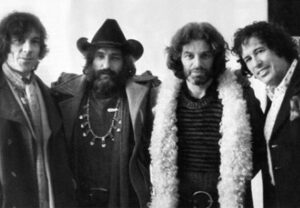
Anger’s Carnaby Street based agent, Jimmy Vaughan, struck a “Faustian” deal with a German TV company -for £20,000- to make documentary about Anger, as he made Lucifer Rising 11. Visibly he tolerates the presence as a necessary evil. He clearly hated the director’s dry, earnest interrogation of his motivation, while resenting exposing his film making process. It’s great viewing – link below.
Anger recreated his role of Magus conjuring the same named deities from a magic circle as he had previously done at the Straight Theater in 1967 (albeit on a less spectacular scale). Conveniently Fraser’s flat was already decorated with mashrabiya screens (presumably c/o Christopher Gibbs, who also set dressed Performance). While the rich, red lacquer corridors suited the project perfectly, the scene that always jars is when Lucifer, covered in blood, gets into a roll top bath beside a large Victorian Bass Ale mirror from a pub! Jimmy Page also appears, glazing lovingly at a portrait of Crowley. They’d met at a Sotheby’s auction in London containing Crowley lots. Supposedly Anger was instrumental in convincing Page to purchase Boleskine, Crowley’s former residence, on the shores of Loch Ness in Scotland. The remote building was acquired solely to perform the Abra-Melin, a gruelling six-month ritual, which Crowley unadvisedly broke off to appear in Paris to defend his position in the Golden Dawn. Crowley’s time at Boleskine has led to many myths, including that he invented the Loch Ness monster to frighten people away while he conducted the ritual and that a curse remained over the property (and Crowley) for not completing the magick. While Led Zeppelin fans imaginations run wild as to what Page did in the house, he gave a very down to earth explanation when I asked him, it was just a get-away, where he could write new material – no satanic worship… nothing creepy going on.
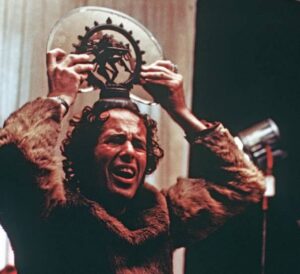
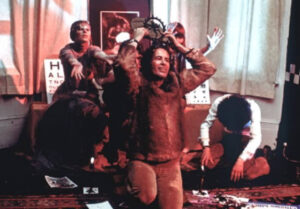
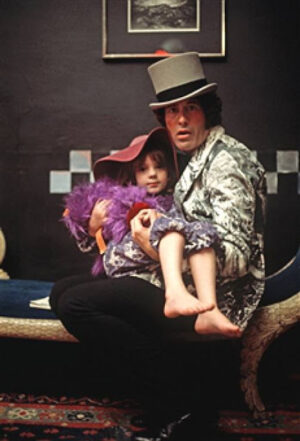
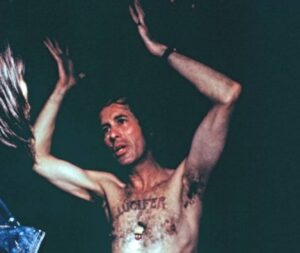

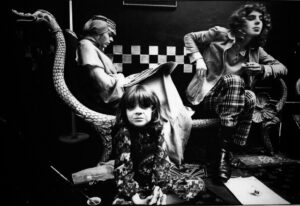
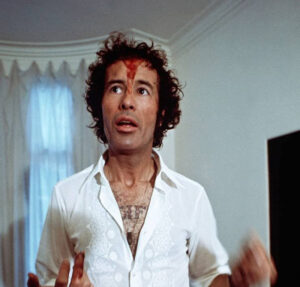
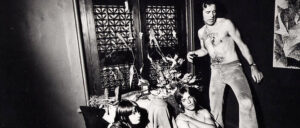
When Anger & the documentary crew arrived on location in Avebury Stone circle (which Anger claimed was the earliest known Sun Temple) his interaction with film unit became outright hostile and filming halted on both projects.
In 1970, Anger published a single sheet poetry broadside of Crowley’s Hymn to Lucifer- the inspiration for the film, via the Dove Press, Canada.
Click Here : Kenneth Anger : Crowley’s Hymn to Lucifer 1970 Poetry Broadside, Dove Press, Canada
: Kenneth Anger : Crowley’s Hymn to Lucifer 1970 Poetry Broadside, Dove Press, Canada
Although Lucifer -Huggins -disappeared once again, Anger had enough footage to present Lucifer Rising, Part I, to the National Film Finance Corporation. Although he was granted £15,000 in completion funds, the conservative Sunday Telegraph newspaper ran a headline “Devil Film to Get State Aid” 28th March 1971.
Despite her previous misgivings, Marianne Faithfull, (who according to her autobiography – now post Jagger, homeless & hopelessly addicted to heroin) agreed to portray the ancient goddess Lilith. Anger also recruited Donald Cammell and his partner Myriam Gibril, to represent Osiris & Isis. Filming took place in both Egypt & Germany. In order to film at the ancient monuments in Giza, Karnak and Luxor Anger had to lie to the Egyptian authorities and pretend he was filming cutaway shots of actors in costume for a historical documentary.
Faithfull once again claimed Anger hadn’t a clue what he was doing as either a director or magician, but seriously addicted to heroin, neither did she. At the final location in Germany, the Neolithic site, Horn-Bad Meinberg, she was so out of it that she rolled down a sheer drop and landed on her feet, unharmed.
Anger’s films are art house, full of implied or allegorical meaning- NOT linear narratives. There seem to have been plenty of participants and collaborators who clearly didn’t understand his filming methods, especially when on Lucifer Rising, not only Faithfull but Beausoleil, Huggins and Chris Jagger …
With enough footage shot, Anger approached Jimmy Page for a soundtrack. He agreed, and allowed Anger to use his basement as a cutting room. Although a version was supposedly screened using Page’s soundtrack in 1973, in 1976 the project still wasn’t deemed complete. Anger blamed Page for only providing 20 mins of music, when he needed 40+. What was he supposed to do – repeat it?
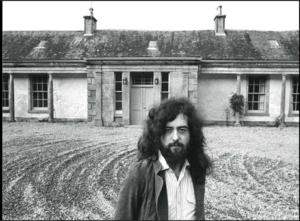
Page’s wife Charlotte, allegedly fed up with Anger’s constant presence threw him out. Various quotes can be found on other websites, declaring Page as drug user, a miser, with no new melodies to offer, presumably he also received one of Angry curses.Whatever the issue, Page’s score is amazing – a complete departure from guitar heroics. It’s been bootlegged on numerous occasions but eventually, in 2012, he revisited, remixed and re-edited for release- via his website.
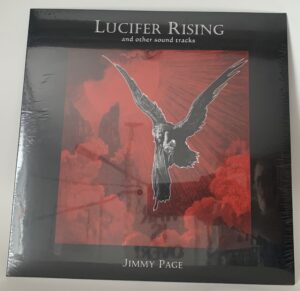
When Beausoleil learned of the new Lucifer Rising Mark II, he contacted Anger from prison and offered to compose a second Lucifer Rising soundtrack. So, while still incarcerated for his role in the Manson murder a decade earlier, Beausoleil formed the Freedom Orchestra and recorded a new soundtrack, which was first issued in 1980.The version of Lucifer Rising, that is now widely in circulation uses his soundtrack and finally in 1981 the project ended, with the original Lucifer. http://bobbybeausoleil.com/index.html
What wasn’t but might have been #2-Link below for the final Lucifer Rising edit with Page’s soundtrack substituted.

